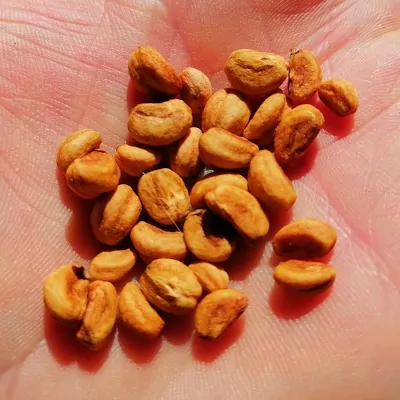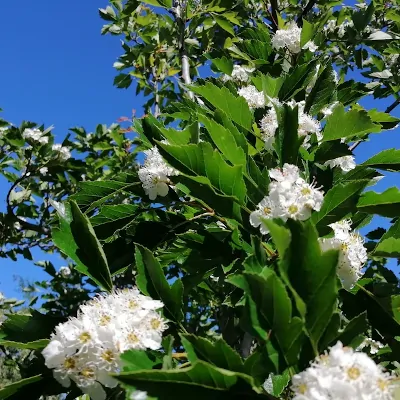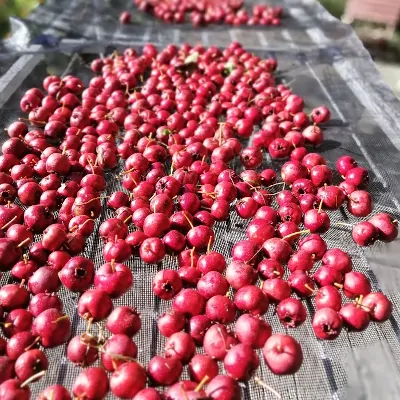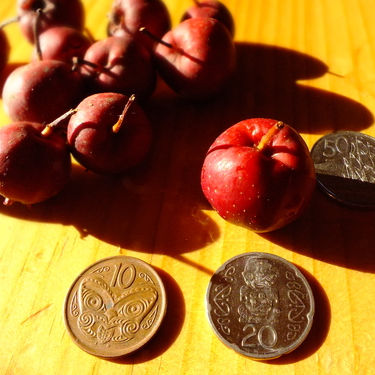Crataegus pinnatifida, commonly known as Chinese hawthorn or Chinese haw, is a deciduous shrub or small tree native to China and widely cultivated in other parts of the world. It is valued for its various uses and qualities, including:
- Edible Fruit: One of the primary uses of Crataegus pinnatifida is for its edible fruit. The fruit, also called hawthorn berries or Chinese hawthorn fruit, is red or yellow when ripe and has a tart flavor. It is commonly used in traditional Chinese cuisine to make jams, jellies, sauces, candies, and herbal teas. The fruit is rich in vitamin C and antioxidants.
- Medicinal Properties: In traditional Chinese medicine, various parts of the Crataegus pinnatifida plant, including the fruit, leaves, and flowers, are used for their medicinal properties. They are believed to have benefits for cardiovascular health, aiding digestion, and promoting blood circulation.
- Ornamental Qualities: Crataegus pinnatifida is often grown as an ornamental plant for its attractive appearance. It has shiny, dark green, deeply lobed leaves that turn a beautiful orange-red in the fall. The plant produces clusters of fragrant white flowers in the spring, adding to its aesthetic appeal.
- Wildlife Support: The fruit of Crataegus pinnatifida is a valuable food source for various wildlife, including birds and small mammals. Planting Chinese hawthorn can help support local wildlife populations and promote biodiversity.
- Erosion Control: Due to its strong and extensive root system, Crataegus pinnatifida is sometimes used for erosion control on slopes and embankments. Its deep roots help stabilize the soil and prevent erosion.
- Drought Tolerance: Chinese hawthorn is relatively drought-tolerant once established, making it suitable for regions with less water availability.
- Cold Hardiness: Crataegus pinnatifida is known for its cold hardiness, which allows it to withstand harsh winters in temperate climates.
It's important to note that while the fruit of Crataegus pinnatifida is generally safe and commonly consumed in culinary applications, the use of the plant for medicinal purposes should be done with caution. If you are considering using the plant for medicinal reasons, it is best to consult with a qualified healthcare professional or herbalist to ensure safe and appropriate use.
How to grow hawthorn trees from seed
Growing hawthorn (Crataegus) from seeds can be a rewarding but somewhat challenging process. Hawthorn seeds need to go through a process called stratification, which simulates winter conditions, to break their dormancy and encourage germination. Here's a step-by-step guide on how to grow hawthorn from seeds: Materials and tools you'll need:
- Hawthorn Seeds: You can collect seeds from mature hawthorn fruit (haws) in Autumn.
- Pot or Seed Tray: You'll need a container for planting the seeds.
- Seed Starting Mix: A well-draining seed starting mix is crucial.
- Plastic Wrap or a Seed Tray Cover: To create a mini greenhouse effect.
- Refrigerator: For stratification.
- Watering Can or Spray Bottle: For maintaining soil moisture.
Steps:
- Collecting Seeds: Collect ripe hawthorn fruit (haws) in the fall when they have turned a deep red or black color. Remove the seeds from the flesh of the fruit.
- Cleaning Seeds: Clean the seeds by removing any remaining fruit flesh or pulp. Rinse them in cool water and let them dry.
- Stratification: a. Place the cleaned seeds in a damp paper towel or in a plastic bag with slightly moist vermiculite. b. Seal the bag or wrap the seeds in the paper towel. c. Put the bag or paper towel with the seeds in the refrigerator for a period of 60-120 days. This mimics the cold stratification that occurs in nature.
- Preparing Seed Trays: a. Fill your seed tray or pots with a good quality seed starting mix. b. Plant the stratified seeds at a depth of about 1/2 inch (1.3 cm). c. Water the soil well to ensure good moisture.
- Germination and Growth: a. Place the seed tray in a location with indirect sunlight. b. Keep the soil consistently moist but not waterlogged. You can use a spray bottle to mist the soil's surface.
- Transplanting: a. After the seedlings have grown several leaves and are sturdy enough to handle (usually when they are a few inches tall), you can transplant them into larger pots or directly into the garden.
- Growing Conditions: a. Hawthorns prefer full sun and well-drained soil. Plant them in a suitable location. b. Space the transplants at least 3-4 feet apart to allow for proper growth.
- Care and Maintenance: a. Water your hawthorn trees regularly during their first growing season. b. Mulch around the base of the plants to help retain soil moisture and prevent weed growth. c. Prune your hawthorn tree as it grows to shape it and remove any dead or diseased branches.
Keep in mind that growing hawthorn from seeds may take a few years to yield a mature plant that produces flowers and fruit. Additionally, hawthorns can be susceptible to various diseases and pests, so be vigilant in your care and maintenance.





